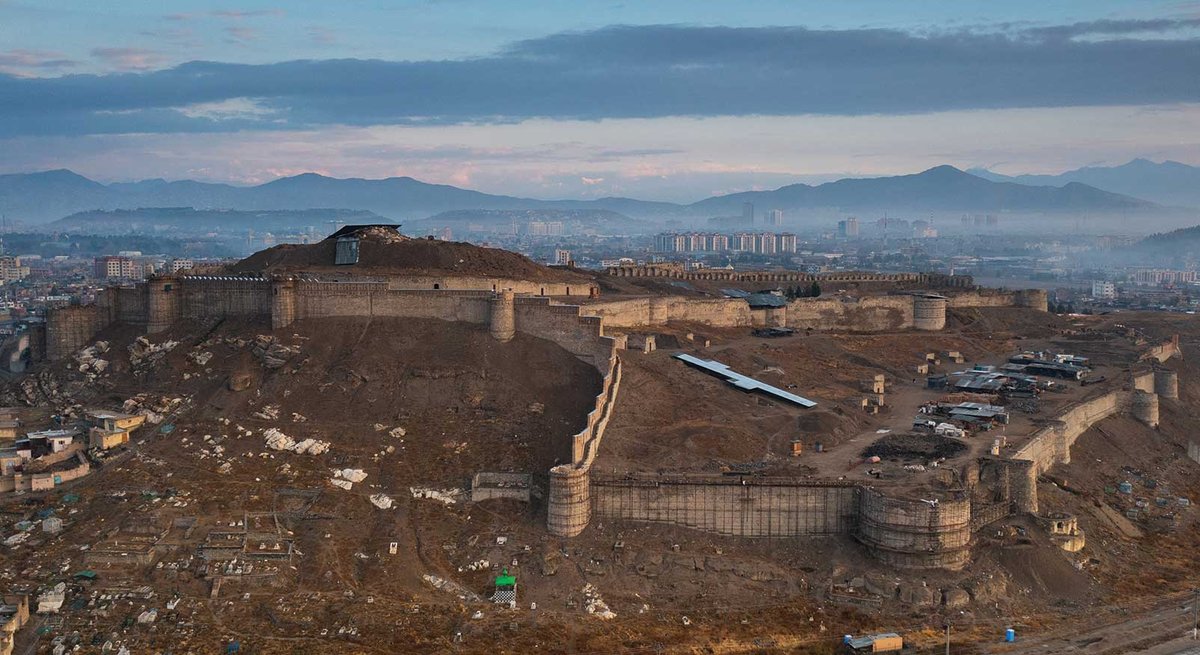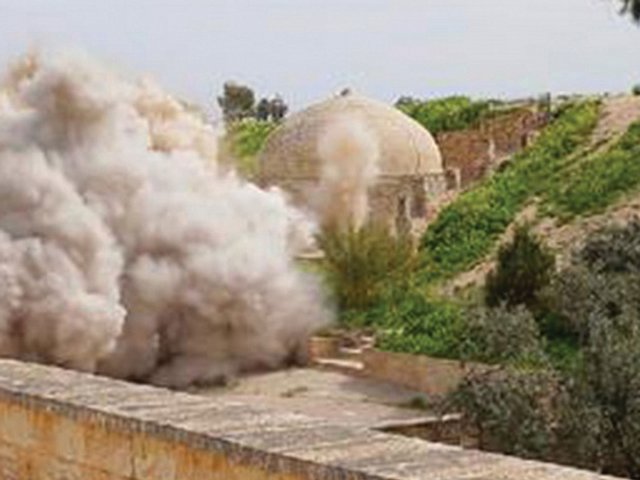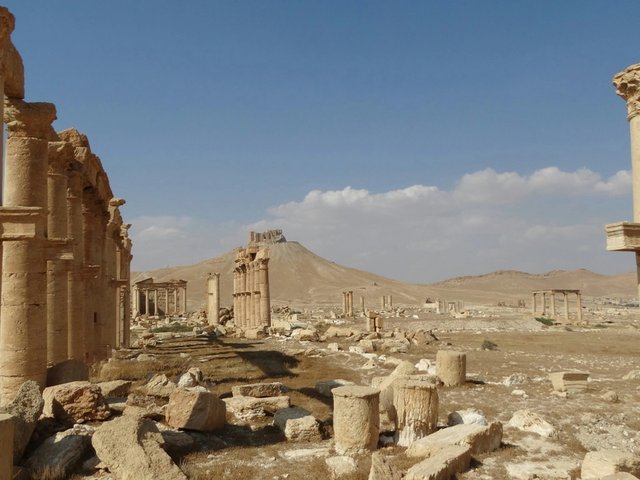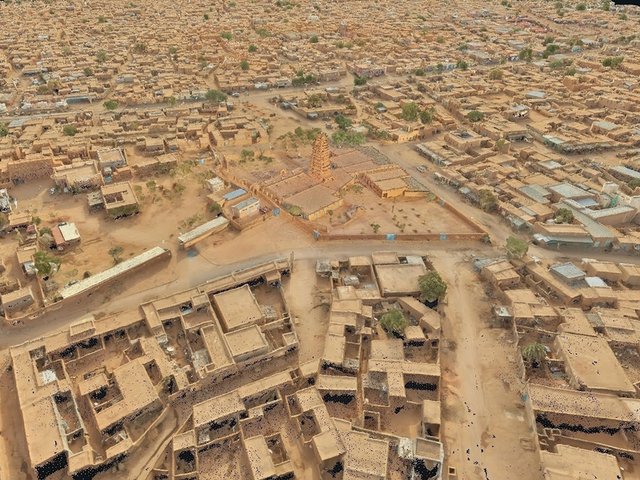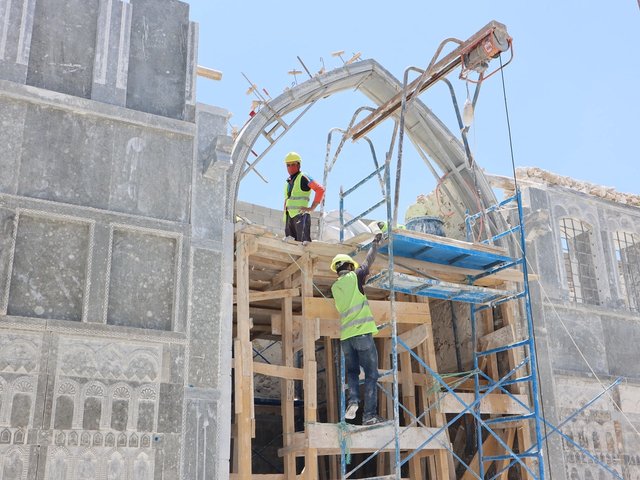Since launching nearly eight years ago, the International Alliance for the Protection of Heritage in Conflict Areas—better known as Aliph, the first letter of the Arabic alphabet—has become a key player in the cultural heritage sector; “the new big kid on the block,” as one specialist put it. Faced with a landscape in which threats to cultural heritage have become more acute—a combination of lasting conflict, climate change, and terrorist activity—the Geneva-based intergovernmental organisation has now supported 470 museums, ancient and archaeological sites, and intangible heritage sites around the world.
“We have been able to grow very fast,” says Valéry Freland, a French diplomat who became the executive director of the organisation in 2018. “And agility has become one of our key assets.”
Rather than implementing projects itself, Aliph is a funding organisation, responding to proposals on a regular grant-making cycle and acting as the first port of call in emergencies. It is this latter role that has become the organisation’s real strength, despite its relatively small size.
When the Sasanian-era Arch of Ctesiphon in southern Iraq was in danger of collapsing in 2020, Aliph provided $775,000 to install emergency scaffolding and other stabilisation measures within days. Three weeks after a massive blast on Beirut’s port in 2020 damaged the structural integrity of the Sursock Museum, Aliph wired over $500,000. And within the first weeks of the Ukrainian war, Aliph were in contact with hundreds of institutions, libraries, and heritage sites to help prepare them for the consequences of an invasion.
“I got the call from Aliph on a Sunday evening,” says Oleksandra Kovalchuk, the deputy director of the Odesa National Fine Arts Museum, who began working with Aliph in the initial days of the Russian invasion in February 2022. “It seemed absolutely impossible that they were calling on a weekend. We received funds four or five days after we talked to Aliph, and we managed to stabilise the situation in our museum to prepare everything for evacuation.”
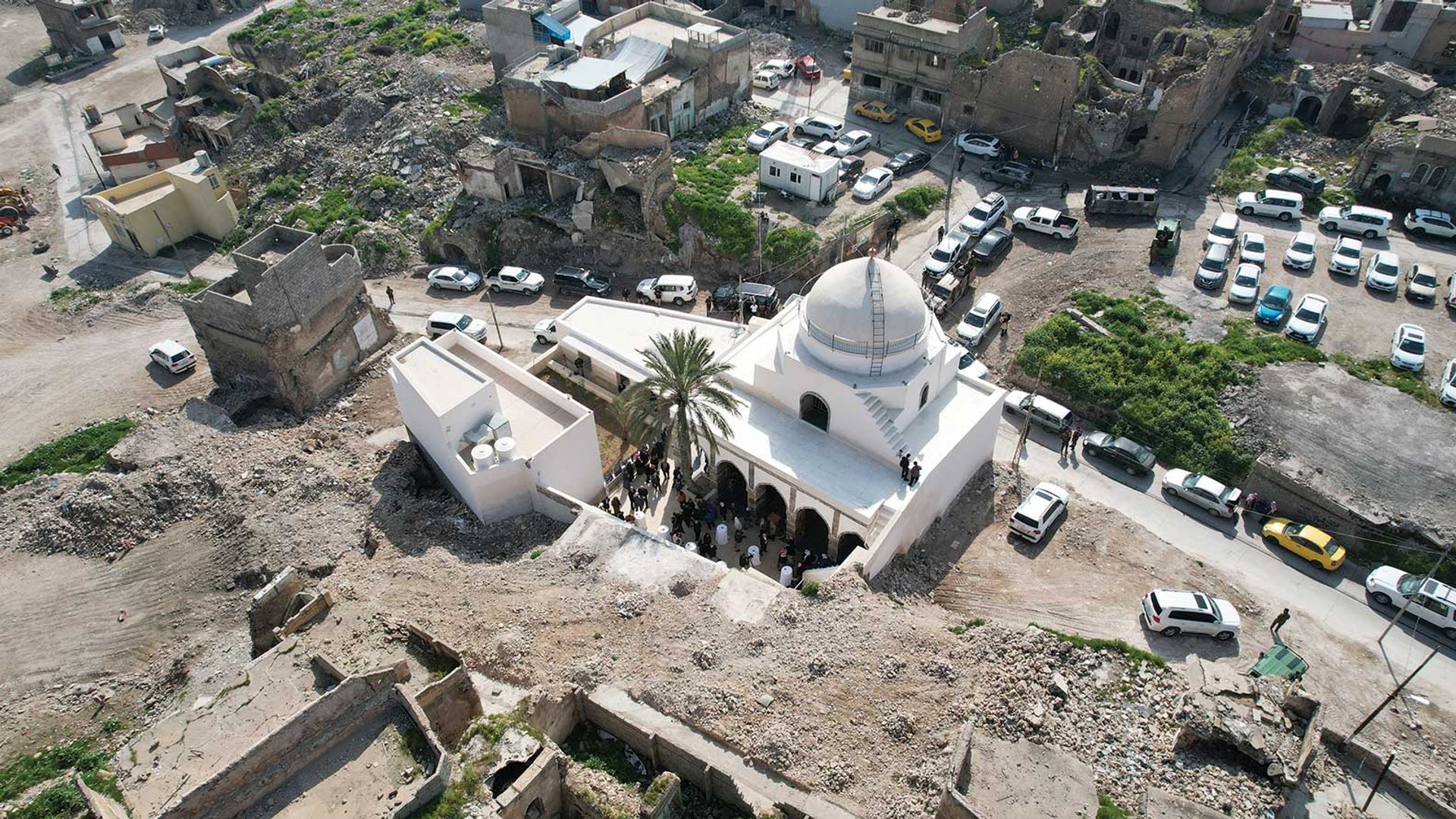
The Al Masfi Mosque in Mosul, damaged by Isis
Photo: © Azhar Al-Rubaie
Aliph was first launched in 2016 as a Franco-Emirati initiative, partially in answer to the threat posed by Islamic State (Isis), and partially as a continuation of the bilateral collaboration that accompanied the run-up to the opening of Louvre Abu Dhabi. In 2015 François Hollande, the then-president of France, asked Jean-Luc Martinez—at the time the director of the Musée du Louvre—to draw up a list of 50 suggestions for further French-United Arab Emirates (UAE) partnership. Among these was a multi-lateral organisation that would act to protect cultural heritage.
Deterring Islamist extremism
Isis was then at the height of its power across northern Iraq and Syria, and the UAE leadership was keen to project itself as a deterrent to Islamist extremism, nationally and internationally. The prospect of continuing work between Emirati and French cultural leaders also made sense. Although Louvre Abu Dhabi was the most conspicuous result, the UAE and France’s close diplomatic relations were felt in various soft-power policies at the time. Many of the stakeholders behind Louvre Abu Dhabi also helped launch Aliph, including Mohamed Khalifa Al Mubarak, the chair of Abu Dhabi’s department of culture and tourism, who is on the board of Aliph, and Hollande, who presided over the organisation’s first two donors’ conferences in Paris and Abu Dhabi.
The second conference was held in March 2017 at the plush Emirates Palace hotel. Heritage experts spoke about the threat of Isis and potential solutions to the destruction, and the proceedings culminated in a heady roll call in which government ministers pledged millions of dollars to the fledgling organisation. Aliph remains majority government-funded and is now in its second funding round. France and the UAE are in leadership positions in the governance, but Saudi Arabia has become the second-largest financial contributor (after France)—and there is talk of a Riyadh office to allow Aliph to strengthen its presence in the Middle East and North Africa (MENA) region. Other donor countries include the US, Kuwait, Morocco, Luxembourg, China and Cyprus, and around 10% of its revenue comes from private philanthropy.
Early on, Aliph concentrated on post-Isis projects in the Middle East, South Asia and North Africa. Working with local and international partners, it undertook significant restoration efforts across Mosul, which had been severely damaged in the battle to liberate the northern Iraq city; it funded the rehabilitation of the Raqqa Museum, which Isis looted and damaged when it used the Syrian city as its capital; and the preservation of manuscripts in the Al-Aqib Library in Mali, which had been badly damaged in attacks by Islamists in 2012. The organisation also recognised climate change as a key threat, moving to stabilise tangible and intangible heritage impacted by desertification, floods and other extreme weather patterns.
But in 2020, when 2,750 tonnes of ammonium nitrate exploded in Beirut’s port, Aliph’s ability to immediately respond fundamentally changed the direction of the organisation. The blast damaged most of the city’s port area and several heritage sites and museums nearby, including the Sursock Museum. Aliph rapidly released money and engaged partners in order to stabilise insecure structures and to begin emergency measures for any damaged artefacts.
This idea of Aliph as an emergency responder was reinforced two years later, when Russia invaded Ukraine. The organisation quickly dispersed funds (ultimately $8m over two years) to the country to allow museums and cultural sites to ready themselves for the anticipated damage from air strikes and combat. Museums and libraries purchased generators and protective panels for windows so they could ensure stable conditions in the event of black-outs and airstrikes and began moving art and artefacts to designated safe areas away from the front.
“Historically speaking, this is the very first time there has been such an initiative of cultural protection,” Freland says. “We have been able, with our local partners, to protect 450 cultural institutions, including historical buildings, museums, archives and libraries, and to create 14 safe areas in other parts of the country,” he says.
Nimble and efficient
Aliph’s quick-response capability is in part due to its relatively small structure and short decision-making process. Its internal team selects projects, which are then evaluated by its scientific committee of experts. The decisions made by this committee can be rapidly green-lighted by the foundation board, which is comprised of representatives of member states and private donors, without having to go back to member states for funding or approval. The system sets it apart from other heritage organisations—particularly Unesco, which many in the field see as hamstrung by bureaucracy.
Like all disruptors, Aliph’s efficiency comes at the expense of established protocols. Its oversight procedures are streamlined, with organisations in the field reporting directly to the Geneva office, and it gives more latitude to partner NGOs. But all the operators The Art Newspaper approached for this article said this flexibility was welcome and even necessary in the kinds of situations that Aliph funds.
“Everyone has to keep in mind that when the war starts, things are very different from normal life,” says Kovalchuk, of the Odesa National Fine Arts Museum. “For example, it was nearly impossible to find OSB shields [panels to protect windows] or fire extinguishers [when the war started] in Ukraine. Prices were higher than average because there was no alternative.”
Packing materials were not available for the transfer to the safe houses, so some Ukrainian museums were forced to use blankets and old towels to wrap paintings and artefacts. Other museums could not get deliveries of the OSB shields, because the centre of the city was blocked by the military. The Fine Arts Museum ended up hiring delivery men to carry the items from the loading vans parked several streets away to the museum in the main square. Rather than having to seek approval for changes to the costings or implementation plan, Kovalchuk says, Aliph gave them latitude to add these on.
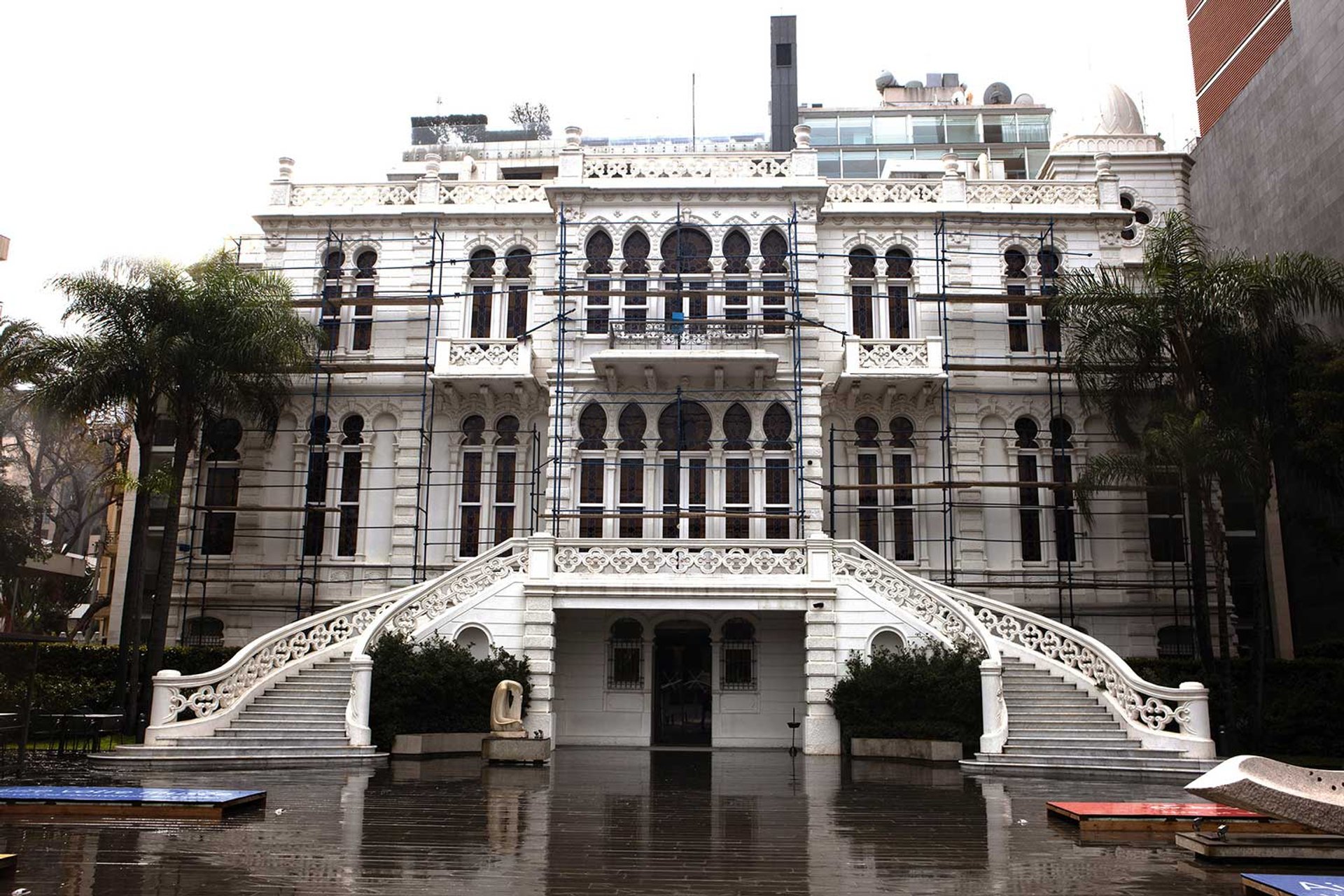
The Sursock Museum, damaged in the catastrophic 2020 Beirut port blast
Courtesy Aliph Media
“We had an emergency grant where we didn’t have to write a long narrative or detailed budget,” she says. “If we had to do that, to be honest, we couldn’t have done it because of the way your body reacts to stress of this level. It was important at that moment that it was a very easy budget, and we knew we could correct it in any way.”
Sources also say that Aliph’s non-political nature is its second key strength. This might seem counter-intuitive for a soft-power initiative, yet Aliph’s track record shows a willingness to work in politically sensitive areas: Yemen, for example, where much of the destruction derived from UAE and Saudi missiles, or Afghanistan, despite its hard-line government. (Unesco does not at present work in Afghanistan because of member states’ policy of non-engagement with the Taliban.) This means that some of the most vulnerable sites can get the attention they need without foreign policy demands.
At the same time, cultural heritage is not a neutral territory. Foreign governments’ investments in other countries’ heritage sectors are often made with an eye to political power or to gaining a foothold in a recovering economy. There are also shades of colonialism, or at least paternalism, in the continuing pattern of wealthy foreigners arriving to save an ancient site.
“While cultural heritage preservation initiatives are needed desperately, given the current continuous destruction, it is equally necessary to decolonise and reform archaic practices that were established under imperial times,” says the Iraqi-American art historian Nada Shabout. “Local experts and concerns are essential and need to be a priority over agendas. We have to always remember that while heritage is for all humanity, it is a living reality for locals.”
Employment standards often differ for local and foreign workers, and agencies sometimes work to support the built heritage of a community that has fled, for instance the Christian enclave in northern Iraq. These problems are bigger than Aliph itself and need to be balanced against the greater good of heritage protection, but they cannot be ignored in assessing the organisation’s successes.
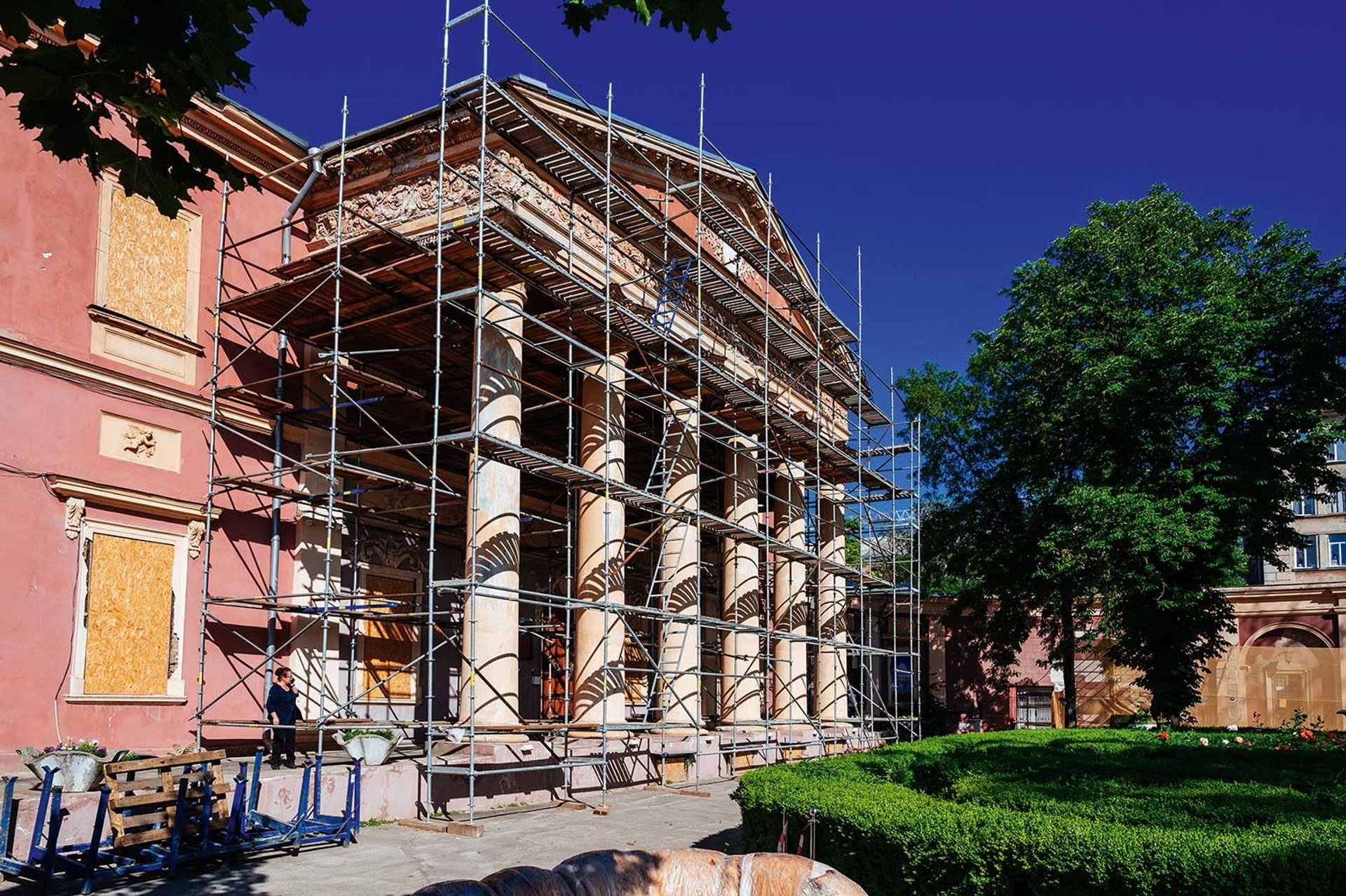
Repairs to the Odesa National Fine Arts Museum, which suffered at the hands of Russian forces
Photo: © Ivan Strakhov
A second challenge that Aliph faces is—sadly—its own optimism. The organisation set itself up as a problem-solver, an answer to the threat posed by Isis, and latterly as a lithe responder to ongoing challenges posed by other conflicts and climate change. But even within the short timeframe of its existence, some of its work has been undone: fighting has been reported near the Meroe Island in Sudan, which Aliph, as part of a Unesco-coordinated team, worked to stabilise after flooding in 2020-21; and it is awaiting news about the status of its former projects in Gaza, including the conservation of an ancient monastery and an Ottoman-era house (completed with the Palestinian agency RIWAQ). There is a sense of moving two steps forward and one step back: Aliph plans to implement emergency measures in both countries as soon as it is able, but it cannot operate on the ground yet.
Aside from the human and historical cost of this damage, it also affects the bottom line: will donors continue to give money to heritage protection in vulnerable areas if a conflict’s root causes persist?
Aliph in brief
Major financial contributions
France $60m
Saudi Arabia $50m
United Arab Emirates (UAE) $39m
US $645,000 (earmarked for a project
to protect archives in Ukraine)
Member states
France, UAE, Saudi Arabia, Kuwait,Luxembourg, China, Morocco, Cyprus
Private donor-members
Thomas S. Kaplan, J. Paul Getty Trust, Fondation Gandur pour l’Art
Host country
Switzerland
Non-member donors
European Union, Oman, Romania, Principality of Monaco, US Ambassadors Fund for Cultural Preservation, TotalEnergies Foundation, Andrew W. Mellon Foundation, Lionel Sauvage Family Foundation
Key projects
2018
• Islamic State (Isis) captured Mosul in 2014, and the city’s old town was severely damaged in the year-long battle to free the city. Aliph worked with partners to stabilise the Mosul Museum and later became a major partner in the Unesco-led effort to rehabilitate the Iraqi city, helping to restore the Church of Our Lady of the Hour and Al Masfi Mosque and reconstruct of the Ottoman-era Tutunji House.
2019
• Aliph worked with the Afghan Cultural Heritage Consulting Organisation to stabilise the 1,800-year-old Buddhist stupa of Shewaki, which had been damaged in the Afghan wars.
2020
• With the World Monuments Fund, Aliph reconstructed the Mam Rashan Yazidi Shrine on Mount Sinjar, in northern Iraq. Isis had destroyed the shrine in its genocide against the Yazidis.
• The 4 August blast on Beirut’s port caused rippling damage throughout the city. Aliph funded a number of first-aid and longer-term protection measures at sites including the Sursock Museum, National Museum, Villa Mokbel and Villa Al Makassed.
2021
• The stabilisation and reconstruction of Afghanistan’s Bala Hissar Citadel—which had been an active military site—has been one of Aliph’s biggest projects. Working with the Aga Khan Trust for Culture and Délégation Archéologique Française au Afghanistan, it stabilised the archaeological remains, set up an educational site, and opened the citadel to the residents of Kabul.
• Niger’s old city of Agadez, built out of mud brick, has faced flash floods as well as civil unrest. With Imane Atarikh, Aliph worked to restore its Great Mosque and surrounding houses.
2022
• Faced with vulnerable infrastructure and political insecurity, Aliph collaborated with theInternational Council of Museums to help 22 museums in Mali and Burkina Faso combat the illegal trafficking of artefacts across the Sahel.
• With the University of Durham, Aliph is documenting and preserving the heritage of the inhabitants of the Nafusā Mountains in Libya.
2023
• Aliph is working with Unesco on shoring up the Lido Secondo Lighthouse in Mogadishu, Somalia, as a record of the city’s significant role as a port in global trade for centuries.
2024
• With civil war raging in Sudan, Aliph and Unesco are providing emergency relief to specialists who can document and preserve Sudan’s intangible heritage that is at risk of being destroyed.


